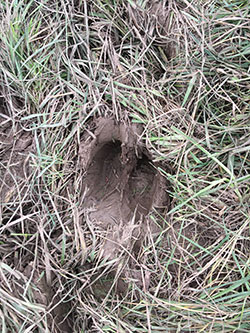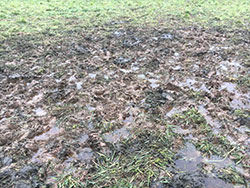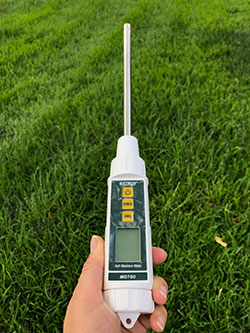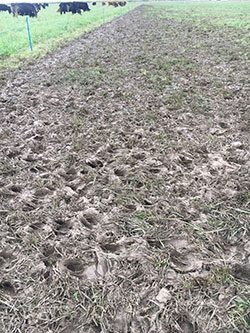by Casey Shawver, Joe Brummer, Jim Ippolito, Jason Ahola, and Ryan Rhoades* (1/20)
Quick Facts…
- Soil physical damage can occur when grazing through pugging and
compaction, especially when soils are wet. - Removing cattle early in a precipitation event can minimize the most
detrimental impacts from grazing on wet soils. - Remediation of pasture soils from compaction using mechanical methods has shown variable results.
- Cattle management, soil monitoring, and contingency plans can be used to mitigate negative impacts to soil.
Grazing and Soil Structure
Soil structure is an important factor that contributes to healthy, functioning soils. The structure of a soil is determined by the way sand, silt, and clay particles are held together in various shapes known as soil aggregates. A soil that has well-formed, stable aggregates will have large pore spaces that allow for air exchange, rapid infiltration of water, and deeply penetrating root systems. When grazing, trampling by cattle can impact soil structure by breaking up aggregates which results in compaction. At some level, compaction is present in most pastures, but can be exacerbated by grazing when soils are wet. In addition, heavy clay soils are more prone to degradation than sandy soils. When wet soils are grazed, surface and subsurface damage can occur due to the effects of pugging (Fig. 1).

Figure 1: Pugging that resulted from grazing during wet conditions post-precipitation.
Pugging breaks up aggregates and causes damage to large soil pores which increases bulk density, resulting in compaction. These soil physical property changes can reduce water and air movement into and through soils, and can impede root growth which results in reduced drought tolerance and pasture yields (5).
Rate of soil degradation depends on soil type, plant litter accumulation, and soil moisture (2, 3, 4), as well as stocking density (i.e., animals per unit area) and grazing duration. Multiple management strategies exist that can be used as tools to mitigate damage to soil when grazing (Table 2). Their use is especially important when employing various grazing systems where animals are concentrated at high stock densities (e.g., short duration grazing, high intensity-low frequency grazing, management-intensive grazing (MiG), and mob grazing).
Managing Trampling on Wet Soil
Trampling on moderately wet soil causes soil remolding around animal’s hooves, resulting in pugging (Fig. 1). The visible indentations caused by pugging generally affect the top 2 inches of soil and can cause direct damage to plant crowns (4). When soils become pugged, the indentations along with reduced water infiltration result in water capture and puddling on the surface which saturates the soil and makes it susceptible to severe pugging damage (Fig. 2) and potential compaction at greater depths (6, 8).
While pugging has direct impacts on soils and vegetation, compaction is considered to be an indirect response to that damage. Current research on mechanical compaction remediation (e.g., aeration, deep ripping, etc.) methods shows varied results with little success in irrigated perennial pasture systems. Without many remediation options for soil compaction besides time and natural processes, strategies to avoid or mitigate negative impacts should be a priority.

Figure 2: Saturated soils lead to
severe pugging after a heavy precipitation event.
Soil water content and soil texture are the most important factors affecting compaction severity. When wet, soils have little structural integrity allowing cattle hooves to cause direct damage to the soil surface and pasture plants. Soil compaction begins to occur as the moisture content of a given soil approaches the plastic limit up until it reaches field capacity. After that point, the soil reaches its liquid limit and the soil compaction risk becomes low but the pugging risk and direct damage to plant crowns remains very high. Field capacity relates to the amount of water a soil can hold after being thoroughly wetted and allowed to drain for 2 to 3 days. A soil at field capacity is wet and will form a soft ball that exudes water on the surface when squeezed (9). For more information on visually determining soil moisture, see the NRCS document Estimating Soil Moisture by Feel and Appearance. The plastic limit refers to the moisture content at which a soil can be rolled into a thread and the thread begins to break apart or crumble at a diameter of about 1/8 inch. Soil compaction damage is not always visible at the surface and can occur at considerable soil depth (greater than 4 inches). Soil trampling should generally be avoided near and beyond the soil plastic limit (7) (Table 1). Pugging and compaction can both occur when a soil is at or beyond the plastic limit, especially when grazing on clay textured soils.
Table 1. Plastic limit and field capacity soil moisture percentages for various soil texture classifications.
| Soil Texture | Plastic Limit (%) | Field Capacity (%) |
| Loam | 20 | 25 |
| Silt Loam | 21 | 29 |
| Silt Clay Loam | 24 | 33 |
| Clay Loam | 27 | 35 |
| Clay | 28 | 35 |
Table 1 lists corresponding soil moisture levels for the plastic limit and field capacity associated with various soil textures. The soil texture(s) in your particular pasture can be obtained from a soil test or the NRCS Web Soil Survey website. Once you have determined the dominant soil texture(s) in your pasture, a soil moisture meter can be used to help monitor and manage grazing decisions. Numerous companies sell digital meters that measure soil water content (Fig. 3). These meters can be used to take quick in-field measurements. Because of in-field variability, it is important to take a minimum of ten random measurements within each major soil type/texture in your pasture and calculate an average soil moisture for each one. It is not necessary to have a moisture meter with long probes (3 to 4 inches is ideal) because surface moisture is generally of greatest concern when grazing.
 |

|
Figure 3: Spectrum technologies Field Scout TDR 150 and Extech MO750 moisture meters
In our experience on an irrigated pasture with a Nunn clay loam soil with close to 40% clay content, the soil moisture value of concern was somewhere between the plastic limit (~27%) and field capacity (~35%). Based on numerous measurements with a soil moisture probe following heavy precipitation events or irrigation, the value that corresponded with significant visual pugging was 30% or greater moisture content. Minor pugging occurred at soil moisture levels between 27 and 30%. Based on these observations, subtracting about 5 percentage points from the field capacity moisture percentage for your given soil(s) (see Table 1) would be a good starting point to identify a damage threshold. Keep in mind that this is only a starting point and must be combined with visual assessments for your particular pasture. Once you get a good feel for a damage threshold percentage that works in your pasture, you can reliably use the soil moisture meter to make decisions.
Most detrimental effects on soil physical properties occur with initial trampling. Removal of stock from pasture during or shortly after heavy rainfall can significantly reduce trampling damage. One strategy is to move cattle to a designated sacrifice area, or to a pasture with sandy soil types where drainage is more rapid.

Figure 4: Severe pugging that occurred due to pacing along the fence line in anticipation of moving to a new paddock.
Another strategy is to significantly lower stocking density (i.e., animals per unit area), which spreads cattle across a larger area of land to minimize impacts in one particular area (1). Moving cattle to new paddocks more frequently reduces the amount of time spent on one area and helps avoid pacing along fence lines that occurs when forage levels begin to decline (Fig. 4). Also, as available forage begins to decline, more soil is exposed allowing greater pugging to occur. Older stands in which the plants have grown together to form a sod or ones that simply have more surface residue present will help to mitigate this issue.
There are numerous variables to consider when making decisions to protect soil and pasture health when grazing. These variables include:
- Amount of recent precipitation and/or irrigation (i.e., cumulative soil moisture)
- Temperature, wind, humidity, and cloud cover (i.e., are conditions adequate for drying)
- Future weather conditions (i.e., is more rain and/or poor drying conditions forecast for the next 3 to 5 days)
With these variables in mind combined with a visual assessment of the degree of pugging occurring and soil moisture levels (if available), the following guidelines can be used to make management decisions (Table 2).
Table 2. Decision making using visual assessment of pugging and soil moisture levels.
| Visual and soil moisture assessment | Management approach |
| Little to no visible pugging, moisture levels below plastic limit for your soil(s), no preciptation in the near-term forecast, and weather favors drying. | Continue grazing as normal |
| Pugging <1″, soil moisture levels at to slightly above plastic limit for your soil(s), no precipitation in the near-term forecast, and weather that favors drying | Options include: Giving cattle double the amount of normal space to graze, moving to a pasture with coarser textured soil, moving more frequently, or moving to a sacrifice pasture |
| Pugging ≤ 1″, soil moisture levels about 5 percentage points below field capacity of higher for your soil(s), forecast calls for continuing precipitation or inadequate drying conditions | Options include: moving cattle to a sacrifice pasture (if forage supply becomes inadequate, consider feeding hay) or removing cattle from pasture and into a drylot (if this is an option) |
References:
- Bilotta, G.S., Brazier, R.E., Haygarth, P.M., 2007. The impacts of grazing animals on the quality of soils,
vegetation, and surface waters in intensively managed grasslands. Adv. Agron. - Chanasyk, D.S., Naeth, M.A., 1995. Grazing impacts on bulk density and soil strength in the foothills fescue
grasslands of Alberta, Canada. Can. J. Soil Sci. 75, 551–557. - Chiavegato, M.B., Rowntree, J.E., Powers, W.J., 2015. Carbon flux assessment in cow-calf grazing systems. J.
Anim. Sci. 93, 4189–4199. - Drewry, J.J., Cameron, K.C., Buchan, G.D., 2008. Pasture yield and soil physical property responses to soil
compaction from treading and
grazing – A review. Aust. J. Soil Res. 46, 237. - Greenwood, K.L., McKenzie, B.M., 2001. Grazing effects on soil physical properties and the consequences for
pastures: A review. Aust. J. Exp. Agric. 41, 1231–1250. - Horne D.J., 1992. Some effects of treading damage by dairy cows. In ‘Proceedings of the 6th National Land
Drainage Seminar.’ Whakatane, New Zealand. (Eds DJ Horne, IFH Furkert) pp. 55-64. (Massey University;
Palmerston North, NZ) - Mapfumo E., Chanasyk D.S., Naeth M.A., Baron V.S., 1998. Forage growth and yield components as influenced
by subsurface compaction. Agron. J. 90, 805-812. - Scholefield D., 1986. The fast consolidation of grassland topsoil. Soil Till. Res. 6, 203-210.
- USDA-NRCS, 1998. Estimating soil moisture by feel and appearance.
Retrieved from: https://www.nrcs.usda.gov/Internet/FSE_DOCUMENTS/nrcs144p2_051845.pdf.





